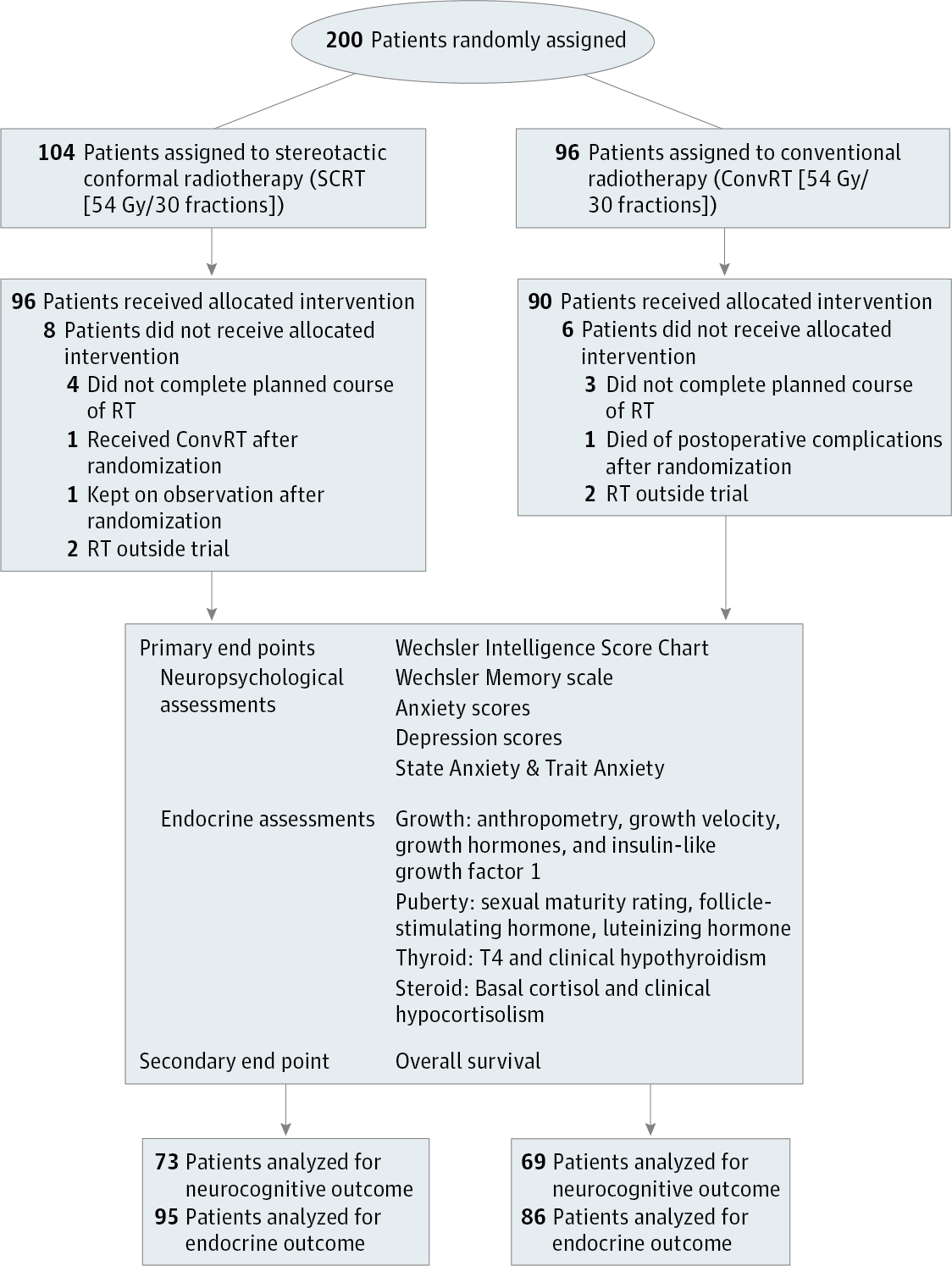JAMA Oncology ( IF 22.5 ) Pub Date : 2017-10-01 , DOI: 10.1001/jamaoncol.2017.0997 Rakesh Jalali 1 , Tejpal Gupta 1 , Jayant S Goda 1 , Savita Goswami 2 , Nalini Shah 3 , Debnarayan Dutta 1 , Uday Krishna 1 , Jayita Deodhar 2 , Padmavati Menon 3 , Sadhna Kannan 4 , Rajiv Sarin 1

|
Importance Evidence for application of stereotactic and other conformal radiotherapy techniques in treating brain tumors is largely based on data derived from dosimetric, retrospective, or small prospective studies. Therefore, we conducted a randomized clinical trial of stereotactic conformal radiotherapy (SCRT) compared with conventional radiotherapy (ConvRT) evaluating clinically meaningful end points.
Objective To compare neurocognitive and endocrine functional outcomes and survival at 5 years in young patients with residual and/or progressive benign or low-grade brain tumors treated with SCRT and ConvRT techniques.
Design, Setting, and Participants This phase 3 randomized clinical trial enrolled 200 young patients (ages 3-25 years) with residual or progressive benign or low-grade brain tumors at a single center between April 2001 to March 2012. Patients were randomly allocated (1:1) to either SCRT (n = 104) or ConvRT (n = 96) arms.
Interventions Patients were randomly assigned to either high-precision SCRT or ConvRT to a dose of 54 Gy in 30 fractions over 6 weeks.
Main Outcomes and Measures Detailed neuropsychological and neuroendocrine assessments were performed at preradiotherapy baseline, at 6 months, and annually thereafter until 5 years on longitudinal follow-up. Change in these functional parameters was compared between the 2 arms as the primary end point and overall survival (OS) as the secondary end point.
Results In total, 200 young patients (median [interquartile range] age, 13 [9-17] years; 133 males and 67 females) were enrolled. Mean full-scale or global intelligence quotient (IQ) and performance IQ scores over a period of 5 years were significantly superior in patients treated with SCRT compared with those treated with ConvRT (difference in slope = 1.48; P = .04 vs difference in slope = 1.64; P = .046, respectively). Cumulative incidence of developing new neuroendocrine dysfunction at 5 years was significantly lower in patients treated with SCRT compared with ConvRT (31% vs 51%; P = .01) while developing a new neuroendocrine axis dysfunction in patients with preexisting dysfunction in at least 1 axis at baseline was also significantly lower in the SCRT arm compared with the ConvRT arm (29% vs 52%; P = .02). Five-year OS in SCRT and ConvRT arms was 86% and 91%, respectively (P = .54).
Conclusions and Relevance In young patients with residual and/or progressive benign or low-grade brain tumors requiring radiotherapy for long-term tumor control, SCRT compared with ConvRT achieves superior neurocognitive and neuroendocrine functional outcomes over 5 years without compromising survival.
Trial Registration clinicaltrials.gov Identifier: NCT00517959
中文翻译:

立体定向适形放疗与常规放疗对良性和低级别脑肿瘤的疗效随机临床试验
应用立体定向和其他适形放射治疗技术治疗脑肿瘤的重要性 证据主要基于来自剂量学、回顾性或小型前瞻性研究的数据。因此,我们进行了一项立体定向适形放射治疗 (SCRT) 与常规放射治疗 (ConvRT) 的随机临床试验,以评估具有临床意义的终点。
目的 比较接受 SCRT 和 ConvRT 技术治疗的残留和/或进行性良性或低级别脑肿瘤的年轻患者的神经认知和内分泌功能结果和 5 年生存率。
设计、设置和参与者 该 3 期随机临床试验在 2001 年 4 月至 2012 年 3 月期间在一个中心招募了 200 名患有残留或进行性良性或低级别脑肿瘤的年轻患者(年龄 3-25 岁)。患者被随机分配( 1:1) 到 SCRT (n = 104) 或 ConvRT (n = 96) 臂。
干预 患者被随机分配接受高精度 SCRT 或 ConvRT,在 6 周内分 30 次接受 54 Gy 的剂量。
主要结果和措施 详细的神经心理学和神经内分泌评估在放疗前基线、第 6 个月以及此后每年进行一次,直至 5 年的纵向随访。在作为主要终点的 2 组和作为次要终点的总生存期 (OS) 之间比较了这些功能参数的变化。
结果 共纳入 200 名年轻患者(中位 [四分位距] 年龄,13 [9-17] 岁;男性 133 例,女性 67 例)。与接受 ConvRT 治疗的患者相比,接受 SCRT 治疗的患者在 5 年内的平均全面或整体智商 (IQ) 和表现 IQ 得分显着优于接受 ConvRT 治疗的患者(斜率差异 = 1.48;P = .04 与斜率差异= 1.64;P = .046,分别)。与 ConvRT 相比,接受 SCRT 治疗的患者 5 年发生新的神经内分泌功能障碍的累积发生率显着降低(31% vs 51%;P = .01)而在基线时至少有 1 个轴功能障碍的患者出现新的神经内分泌轴功能障碍的同时,与 ConvRT 组相比,SCRT 组也显着降低(29% 对 52%;P = .02)。SCRT 和 ConvRT 组的 5 年 OS 分别为 86% 和 91% ( P = .54)。
结论和相关性 在需要放疗以长期控制肿瘤的残留和/或进行性良性或低级别脑肿瘤的年轻患者中,与 ConvRT 相比,SCRT 在 5 年内实现了卓越的神经认知和神经内分泌功能结果,而不会影响生存率。
试验注册 临床试验.gov 标识符:NCT00517959


















































 京公网安备 11010802027423号
京公网安备 11010802027423号